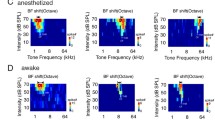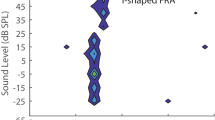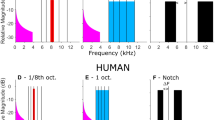Summary
Responses of units in the auditory forebrain (field L/hyperstriatum ventrale-complex) of awake domestic chicks were studied to frequency-modulated (FM) signals and isointensity tone bursts, presented to the ear contralateral to the recording sites. FM signals, linear frequency sweeps in the range of 50 Hz to 10.25 kHz, differed in the rate of change of frequency (RCF) and in the direction of modulation. The majority of RCF response functions obtained could be classified as predominantly ascending and bell shaped. Best rates of change of frequency (BRCFs), assigned to these functions, covered a range of nearly 3 orders of magnitude. BRCFs of the same units for upward (positive BRCFs) and for downward modulations (negative BRCFs) were correlated. The lowest BRCF encountered among all units for a given isointensity ON-response bandwidth (ΔF on ) increased as a function of ΔF on . ΔF on was derived from the responses to tone bursts of various frequencies at 70 dB SPL. As ΔFON tended to increase with the best frequency (BF) of units the lowest BRCF encountered among all units for a given BF also increased as a function of BF. Positive and negative BRCFs of a unit were also correlated with the slopes of onset latency-frequency relationships below and above BF, respectively. FM responses were optimal, when the frequency-specific latency differences at a given unit were compensated by the direction and rate of frequency change in the signal. FM-directional sensitivity varied with BF. Most units with BFs below about 2 kHz preferred upward modulations, while those with BFs above 2 kHz preferred downward modulations. Directional preference and sensitivity correlated with asymmetric distributions of inhibitory sidebands around BF, as derived from the analysis of OFF-responses. Maximum directional sensitivity for a given BRCF increased with BRCF. BRCF and FM-directional sensitivity were topographically organized on neuronal planes harboring units with similar BFs (“isofrequency planes”). Highest BRCFs were observed in the input-layer L2 of field L. BRCF declined along a rostrocaudal isofrequency axis in all 4 subdivisions of the auditory forebrain. Similarly, response strength shifted from rostral to caudal as a function of RCF. FM-directional sensitivity was organized in a subdivision-specific fashion. Units in the input-layer of field L (L2), and even more so in the hyperstriatum ventrale, were fairly insensitive to the direction of modulation, whereas units in the postsynaptic layers of field L (L1 and L3) exhibited higher degrees of directional sensitivity. Directional sensitivity also declined along the rostrocaudal isofrequency axis of field L. Two simple models of connectivity in the chick auditory forebrain are presented, which could be sufficient to explain these results. One is based on a tonotopic arrangement of afferent synapses on dendrites and somata of units in L2, the other on local lateral inhibition in the postsynaptic layers of field L.
Similar content being viewed by others
Abbreviations
- BF:
-
best frequency (kHz)
- BRCF:
-
best rate of change of frequency (kHz/s)
- DS:
-
index of FM-directional sensitivity
- ΔF on :
-
ON-response bandwidth (kHz)
- ΔF off :
-
OFF-response bandwidth (kHz)
- FM:
-
frequency modulation
- RCF:
-
rate of change of frequency (kHz/s)
References
Barlow HB, Levick WR (1965) The mechanisms of directionally selective units in rabbit's retina. J Physiol (Lond) 178:477–504
Biederman-Thorson M (1970) Auditory responses of units in the ovoid nucleus and cerebrum (field L) of the ring dove. Brain Res 24:247–256
Bigalke-Kunz B, Rübsamen R, Dörrscheidt GJ (1987) Tonotopic organization and functional characterization of the auditory thalamus in a songbird, the European starling. J Comp Physiol A 161:255–266
Bonke BA, Bonke D, Scheich H (1979a) Connectivity of auditory forebrain nuclei in the Guinea fowl (Numida meleagris). Cell Tissue Res 200:101–121
Bonke D, Scheich H, Langner G (1979b) Responsiveness of units in the auditory neostriatum of the Guinea fowl (Numida meleagris) to species-specific calls and synthetic stimuli. I. Tonotopy and functional zones of field L. J Comp Physiol 132:243–255
Bräucker R (1986) Die Herzfrequenzkonditionierung als Methode zur Messung psychophysischer Wahrnehmungs und Unterscheidungsschwellen an Vögeln. Dissertation, Ruhr-Universität Bochum
Britt R, Starr A (1976) Synaptic events and discharge patterns of cochlear nucleus cells. II. Frequency-modulated tones. J Neurophysiol 39:179–194
Brugge JF, Dubrovsky NA, Aitkin LM, Anderson DJ (1969) Sensitivity of single neurons in the auditory cortex of cat to binaural stimulation: effects of varying interaural time and intensity. J Neurophysiol 32:1005–1024
Collias N, Joos M (1953) The spectrographic analysis of sound signals of the domestic fowl. Behaviour 5:175–188
Dooling RJ, Saunders JC (1975) Hearing in the parakeet: absolute thresholds, critical ratios, frequency difference limens, and vocalizations. J Comp Physiol Psychol 88:1–20
Erulkar SD, Butler RA, Gerstein GL (1968a) Excitation and inhibition in the cochlear nucleus. II. Frequency-modulated tones. J Neurophysiol 31:537–548
Erulkar SD, Nelson PG, Bryan JS (1968b) Experimental and theoretical approaches to neural processing in the central auditory pathway. In: Neff WD (ed) Contributions to sensory physiology. Academic Press, New York (vol III, pp 150–184)
Ganz L, Felder R (1984) Mechanisms of directional selectivity in simple neurons of the cat's visual cortex analyzed with stationary flash sequences. J Neurophysiol 51:294–324
Gardner EP, Costanzo RM (1980) Neuronal mechanisms underlying direction sensitivity of somatosensory cortical neurones in awake monkeys. J Neurophysiol 43:1342–1354
Greenevalt CH (1968) Bird song. Acoustics and physiology. Smithsonian Institutional Press, Washington DC
Greenwood DD, Maruyama N (1965) Excitatory and inhibitory response areas of auditory neurones in the cochlear nucleus. J Neurophysiol 28:863–892
Heil P, Scheich H (1985) Quantitative analysis and two-dimensional reconstruction of the tonotopic organization of the auditory field L in the chick from 2-deoxyglucose data. Exp Brain Res 58:532–543
Heil P, Scheich H (1991a) Functional organization of the avian auditory cortex analogue. I. Topographic representation of isointensity bandwidth. Brain Res 539:110–120
Heil P, Scheich H (1991b) Functional organization of the avian auditory cortex analogue. II. Topographic distribution of latency. Brain Res 539:121–125
Heil P, Scheich H (1992a) Postnatal shift of tonotopic organization in the chick auditory cortex analogue. Neuroreport 3:381–384
Heil P, Scheich H (1992b) Spatial representation of frequencymodulated signals in the tonotopically organized auditory cortex analogue of the chick. J Comp Neurol 322:548–565
Heil P, Langner G, Scheich H, Camargo C (1989) Processing of pure tone and frequency-modulated stimuli by units in the avian auditory forebrain. In: Erber J, Menzel R, Pflüger H-J, Todt D (eds) Neural mechanisms of behavior. Thieme, Stuttgart New York, p 126
Heil P, Rajan R, Irvine DRF (1992a) Sensitivity of neurons in cat primary auditory cortex to tones and frequency-modulated stimul. I. Effects of variation of stimulus parameters. Hearing Res (in press)
Heil P, Rajan R, Irvine DRF (1992b) Sensitivity of neurons in cat primary auditory cortex to tones and frequency-modulated stimuli. II. Organization of response properties along the “isofrequency” dimension. Hearing Res (in press)
Hose B, Langner G, Scheich H (1987) Topographic representation of periodicities in the forebrain of the mynah bird: one map for pitch and rhythm? Brain Res 422:367–373
Klump GM (1991) Detection of upward and downward frequency sweeps in the European starling (Sturnus vulgaris). Naturwissenschaften 78:469–470
Knipschild M, Dörrscheidt GJ, Rübsamen R (1992) Setting complex tasks to single units in the avian auditory forebrain. I: Processing of complex artificial stimuli. Hearing Res 57:216–230
Langner G (1983) Evidence for neuronal periodicity detection in the auditory system of the Guinea fowl: implications for pitch analysis in the time domain. Exp Brain Res 52:333–355
Leppelsack H-J (1974) Funktionelle Eigenschaften der Hörbahn im Feld L des Neostriatum caudale des Staren (Sturnus vulgaris, L., Aves). J Comp Physiol 88:271–320
Maier V (1982) Acoustic communication in the Guinea fowl (Numida meleagris): Structure and use of vocalisations, and the principles of message coding. Z Tierpsychol 59:29–83
Mendelson JR, Cynader MS (1985) Sensitivity of cat primary auditory cortex (AI) neurons to the direction and rate of frequency modulation. Brain Res 327:331–335
Mendelson JR, Schreiner CE, Grasse K, Sutter M (1988) Spatial distribution of responses to FM sweeps in cat primary auditory cortex. Abstr Ass Res Otolaryngol 11:199
Møller AR (1974) Coding of sounds with rapidly varying spectrum in the cochlear nucleus. J Acoust Soc Am 55:631–640
Møller AR (1977) Coding of time-varying sounds in the cochlear nucleus. Audiology 17:446–468
Müller CM, Scheich H (1988) Contribution of GABAergic inhibition to the response characteristics of auditory units in the avian forebrain. J Neurophysiol 59:1673–1689
Nelson PG, Erulkar SD (1963) Synaptic mechanisms of excitation and inhibition in the central auditory pathway. J Neurophysiol 26:908–923
Nelson PG, Erulkar SD, Bryan JS (1966) Responses of units of the inferior colliculus to time-varying acoustic stimuli. J Neurophysiol 29:834–860
Phillips DP, Judge PW, Kelly JB (1988) Primary auditory cortex in the ferret (Mustela putorius): neural response properties and topographic organization. Brain Res 443:281–294
Phillips DP, Mendelson JR, Cynader MS, Douglas RM (1985) Responses of single neurones in cat auditory cortex to timevarying stimuli: frequency-modulated tones of narrow excursion. Exp Brain Res 58:443–454
Rall WA (1964) Theoretical significance of dendritic trees for neuronal input-output relations. In: Reiss RF (ed) Neural theory and modelling. Stanford University Press, Stanford, pp 73–97
Rose JE, Greenwood DD, Goldberg JM, Hind JE (1963) Some discharge characteristics of single neurones in the inferior colliculus of the cat. I. Tonotopical organization, relation of spikecounts to tone intensity, and firing patterns of single elements. J Neurophysiol 26:294–320
Sillito AM (1977) Inhibitory processes underlying the directional specificity of simple, complex and hypercomplex cells in the cat's visual cortex. J Physiol (Lond) 271:699–720
Sinex DG, Geisler CD (1981) Auditory-nerve fiber responses to frequency-modulated tones. Hearing Res 4:127–148
Sinnott JM, Sachs MB, Hienz RD (1980) Aspects of frequency discrimination in passerine birds and pigeons. J Comp Physiol Psychol 94:401–415
Suga N (1965a) Analysis of frequency modulated sounds by auditory neurons of echolocating bats. J Physiol (Lond) 181:26–53
Suga N (1965b) Functional properties of auditory neurones in the cortex of echolocating bats. J Physiol (Lond) 181:671–700
Suga N (1968) Analysis of frequency-modulated and complex sounds by single auditory neurones of bats. J Physiol (Lond) 198:51–80
Suga N (1973) Feature extraction in the auditory system of bats. In: Møller AR (ed) Basic mechanisms of hearing. Academic Press, New York, pp 675–744
Theurich M, Müller CM, Scheich H (1984) 2-Deoxyglucose accumulation parallels extracellularly recorded spike activity in the avian auditory neostriatum. Brain Res 322:157–161
Walmsley B, Stuklis R (1989) Effects of spatial and temporal dispersion of synaptic input on the time course of synaptic potentials. J Neurophysiol 61:681–687
Warren S, Hamalainen HA, Gardner EP (1986) Objective classification of motion- and direction-sensitive neurons in primary somatosensory cortex of awake monkeys. J Neurophysiol 56:598–622
Whitfield JC, Evans EF (1965) Responses of auditory cortical neurons to stimuli of changing frequency. J Neurophysiol 28:655–672
Whitsel BL, Ropollo JR, Werner G (1972) Cortical information processing of stimulus motion on primate skin. J Neurophysiol 35:691–717
Wyatt HJ, Daw NW (1975) Directionally selective ganglion cells in the rabbit retina: specification for stimulus-direction, size and speed. J Neurophysiol 38:613–626
Author information
Authors and Affiliations
Rights and permissions
About this article
Cite this article
Heil, P., Langner, G. & Scheich, H. Processing of frequency-modulated stimuli in the chick auditory cortex analogue: evidence for topographic representations and possible mechanisms of rate and directional sensitivity. J Comp Physiol A 171, 583–600 (1992). https://doi.org/10.1007/BF00194107
Accepted:
Issue Date:
DOI: https://doi.org/10.1007/BF00194107




